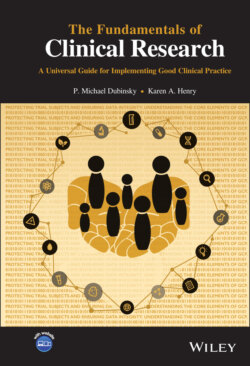Читать книгу The Fundamentals of Clinical Research - P. Michael Dubinsky - Страница 137
11.3 Definition and Overview
ОглавлениеWhen one reviews the ICH E6(R2), the number of references to the regulatory authorities (regulators) is limited and there is no specific section devoted to delineating roles or responsibilities for this important player in the clinical trial process. Regulatory authorities are of course mentioned several times in the body of the ICH E6(R2) guideline. Examples include Section 5.10 Notification/Submission to Regulatory Authority (ies) and Section 5.20.2 – Noncompliance – which speaks to the need for regulatory authorities to be notified if an investigator is terminated from participation in a trial. Therefore, one needs to look elsewhere to fully frame out and define the roles and responsibilities of the regulatory authority from a GCP standpoint.
The ICH E6(R2) guideline does, however, include a definition of a regulatory authority and it is useful to reflect on it because it sets the stage for how these entities fit, from a GCP standpoint into the clinical trial arena. The definition reads in part: Regulatory Authorities: Bodies having the power to regulate. In the ICH E6(R2) guidance, the expression “Regulatory Authorities” includes the authorities that review submitted clinical data and those that conduct inspections (see Section 1.29). These bodies are sometimes referred to as competent authorities. Note: The terms Regulatory Authority, regulator, and competent authority all are used in this topic write up interchangeably.
The roles of regulatory authorities in the oversight of clinical trials have been an evolutionary process often driven by tragic events. As noted in Chapter 1 History, the topic the birth defects caused by the product Thalidomide in many newborns was instrumental in moving legislative bodies worldwide to require substantial evidence of safety and effectiveness before allowing a new drug product on the market. Such events and the failure of industry or professional groups to self‐regulate in an effective manner have all too often been the match that lit the fire of regulatory change.
The regulator’s clinical trial responsibilities are assigned and founded in the laws, statutes, regulations, and directives that are put in place by a country or region’s legislative bodies. Well‐known examples of such laws are the USA’s Federal Food Drug and Cosmetic Act and the EU’s Clinical Trial Directive 2001/20/EC and the EU’s Clinical Trial Regulation 536/2014 which supersede the Directive.
This chapter’s discussion of the regulatory authority will focus on how they intersect with the other key players in performing their roles in the conduct and implementation of the clinical trial process as well as the underlying responsibilities for which they are held accountable.
Figure 11.1 depicts the Regulatory Authority’s interaction with the other players in the clinical trial arena.
